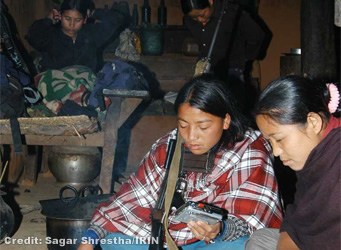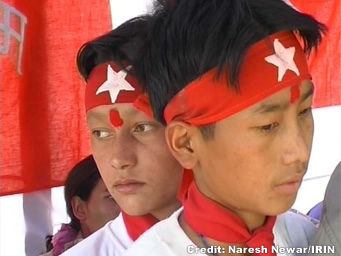 |
| Child Soldiers in Nepal |
|
|
|
|
|
|
|
|
|
| Rights activists demand rehabilitation of child soldiers |
KATHMANDU,
15 Aug 2006 (IRIN)
Rights groups are concerned that peace talks to end Nepal's decade-long conflict have ignored the disarming and rehabilitation of child soldiers.
Tarak Dhital, of the local NGO Child Workers in Nepal (CWIN), said the demilitarisation, demobilisation and reintegration(DDR) of child soldiers had to be given top priority.
"This issue has not been raised in any of the peace talks yet," Dhital said.
Maoists rebels and government forces stopped fighting in April after a mass uprising led by the country's seven parties forced King Gyanendra to end direct rule. The rebels and interim government have been in peace talks since May.
But activists are frustrated that both sides have ignored implementing a DDR process for children.
"The saddest part is that they fail to realise that children have been most heavily affected and used in the armed conflict," Dhital said.
Child supporters of the Maoists - many are kidnapped or coerced into serving with the rebels
 |
|
A large number of children were abducted and forced to work for the Maoists, she said.
The United Nations Children's Fund (UNICEF) defines a child soldier as any person under 18 years old who is "part of any kind of regular or irregular armed force or group in any capacity, including but not limited to cooks, porters, messengers and those accompanying such groups, other than purely as family members. It does not, therefore, only refer to a child who is carrying or has carried arms."
Children were used in all the above roles with appalling consequences, CWIN said. Several who worked as porters, cooks or musicians had disappeared after their arrest and illegal detention by security forces.
Watchlist on Children and Armed conflict, an international watchdog, said children who were used as informers by government forces had been tortured by the Maoists. It said that up to 30 percent of Maoist forces were children.
Insec, a prominent Nepalese human rights group, said Maoists and government forces had been responsible for the killing of a large number of children, many of whom were under 15 years old. It estimated 346 had been killed between February 1996 and June 2006.
 |
|
The UN's office in Nepal was also working with child protection agencies to prepare an action plan for returning children and those affected by the conflict, to their families, UNICEF said.
Rosanna Vega, a UNICEF child protection officer in Nepal, said early intervention was critical for the normal development of children employed in the conflict, even with the peace process.
"If you don't act now, it could be too late," Vega said.
Activists were planning to strongly lobby for a child-DDR process.
"For a start, we need both sides to make a public appeal that they would begin the process and ensure safe return and provisions, including free education, for these children," Bhola Dahal, an expert from Save the Children (Norway), said.
| Credit
IRIN 2006 Copyright Ⓒ UN Office for the Coordination of Humanitarian Affairs 2006 [ This report does not necessarily reflect the views of the United Nations] Integrated Regional Information Networks (IRIN), part of the UN Office for the Coordination of Humanitarian Affairs (OCHA). |
| Links |
| External links |
|
|
 |
|
|

